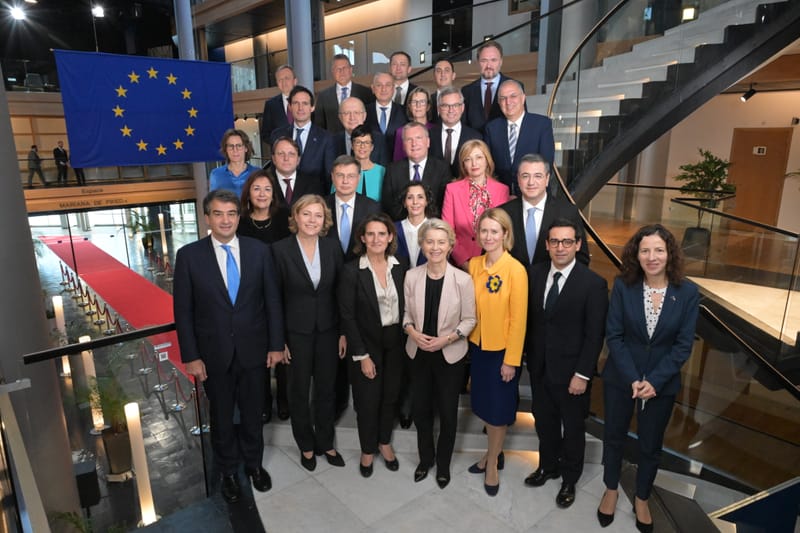AI race revisited: how long until China catches up and what can EU & the US do to cooperate better
The the EU, US, Japan, Canada, Australia, South Korea, and other liberal democracies should identify barriers to successful AI cooperation and work on reducing among their economies.
The European Chips Act and the US CHIPS and Science Act are meant to be Brussels’ and Washington’s Apollo programs to secure semiconductor self-sufficiency, a significant element in the global AI race. Despite these two large programs, there are questions about whether these responses focusing on subsidies and protecting local markets are the most successful strategies or whether supercharged trans-Atlantic cooperation and boosting competitiveness on both sides of the Atlantic might be a better panacea to keep up with China.
While France and Germany made significant leaps in AI over the past years, the US and China remain the absolute leaders, with the US still holding a relative advantage in technological capacity, compared to China.
In supercomputing, the US leads globally with operational exascale systems, the EU is investing and scaling fast with pre-exascale capacity, while China’s true capabilities are considered big, but we know less about it.
Policy-wise, the EU has adopted a centralized, risk-based approach via the EU Artificial Intelligence Act. The US has yet to make decisions regarding federal-state AI regulation, while China has adopted strict, state-oriented regulatory control over AI algorithms and AI use.
The global AI race continues, with open questions on transatlantic cooperation on AI remaining.
What is the potential of AI
The recent advancements in AI, or computer-intelligence-driven automation, are making waves worldwide. While the debate on whether these breakthroughs in machine learning will quickly lead us to live with semi-sentient software and emotional robots is still somewhat present, the primary focus today is on narrow AI, it is clear that these supercharged algorithms can bring massive productivity gains in all sectors of the economy. From better harvest forecasts, quicker medical diagnoses, and fast and cheap translations to autonomous driving, humanity can leap forward in productivity and make things more affordable.
A big open question remains about the global capacity to agree on global rules for the use of AI since the technology can always be used for evil purposes (e.g., surveillance, misinformation, and autonomous weapons).
What inputs are needed for supercharging AI?
But while offering productivity boosts, the large-scale application of ever-smarter algorithms also requires a series of inputs growing at the same (or at least at a growing) rate in order to facilitate better models.
Lots of computing power is needed for scaling up AI applications, and most of these chips are being manufactured in a few Asian countries leading to calls and policy actions in the US and Europe to spend hundreds of billions on subsidies to ‘re-shore’ manufacturing of an industry that was once dominated by Europe and the US: Over 85% of all chips manufactured globally originate in Asia and when looking at very advanced chips used for complex AI models the Taiwanese company TSMC controls 90% of the global market.
The International Energy Agency estimates that between 5 and 6 percent of all European and US energy demand will come from data centers by 2026. Policies that allow for cheap and available energy are needed to boost the use of data centers. For many European countries, this also requires a paradigm shift in their approach towards nuclear power.
Let’s not forget that without tech and data talent, no new algorithms or chip factories will be made. Competitive immigration and labor policies are needed to retain and attract global talent.
How can Europe and the US work hand in hand?
“The AI Act is the first-ever legal framework on AI, which addresses the risks of AI and positions Europe to play a leading role globally.”
It is almost telling that the European Union’s website first mentions the risks of AI before showing its ambition to play a leading role in this new technology. While policymakers’ honest approach is commendable, as are recent initiatives to help European AI startups via various financial mechanisms and increased supercomputing capacity, more ambitious action is needed.
“We believe that we must out-compete our adversaries and mitigate the threats posed by adversary use of AI,”
said a Biden administration official cited by AFP.
This is a laudable approach from the White House, but it fails to acknowledge the potential of working with friendly nations on a larger AI trading block instead of each liberal democratic trading block trying its own winning strategy.
Outcompeting each other with subsidies for new chip factories and blocking the growth of the trans-Atlantic energy trade are not driving factors for a more integrated AI market. Quite the contrary, both the EU and the US should revisit transatlantic cooperation on AI and look for ways not to mirror their value chains, aiming to complement, not compete. This is especially important for the Europeans since the EU cannot compare to the US's technological, R&D, and industry capabilities.
Parts of the EU’s data protection rules and the AI Act are also not conducive to attracting more foreign direct investments to Europe’s artificial intelligence sector. A Brookings report from 2023 suggests steps on both sides of the Atlantic to prevent further divergence of the blocks’ AI approach:
“The U.S. and EU should deepen knowledge sharing on several levels, including on standards development; AI sandboxes; large public AI research projects and open-source tools; regulator-to-regulator exchanges; and developing an AI assurance ecosystem.”
It is worth remembering that Europe and the US dominated the global chip market until the 1990s and gradually lost their competitive edge due to growing labor, energy, and regulatory costs. Hundreds of billions of Euros or Dollars of subsidies and protectionist measures won't improve competitiveness in the long term but will just serve as a short-term band-aid. The most competitive and innovation-friendly economies will win the AI race; this is where talent wants to and can thrive.
Combating China’s industrial policy with their recipes, such as subsidies and trade restrictions, is not what tech companies once made great in liberal democracies, but embracing market-based competitiveness is.
Ultimately, the EU, US, Japan, Canada, Australia, South Korea, and other liberal democracies should identify barriers to successful AI cooperation and work on reducing among their economies.







